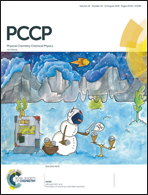Viscous field-aligned water exhibits cubic-ice-like structural motifs†
Abstract
Strong electric fields are known to greatly accelerate the freezing of water in molecular dynamics simulations, and have also been shown to affect the thermodynamics of the phase transition. In this work, a mechanistic explanation for field-induced crystallization of water is presented. Due to the coupling between the rotational and the translational degrees of freedom of individual water molecules, an applied field can directly drive the formation of cubic-ice like local motifs in water. Analysis of the angular distributions of water molecules in TIP4P-2005 water at field strengths between 0.0 and 0.32 V Å−1 demonstrates the existence of such motifs in the field-aligned liquid phase that is observed prior to the onset of the freezing transition. The dynamic properties of this field-aligned liquid phase are also studied, and its viscosity is shown to be within a factor of two of that of regular liquid water using the Green–Kubo method as well as mean squared displacements. The choice between the NPT and the NVT ensembles is shown to have a strong impact on the evolution of molecular dynamics trajectories at field strengths close to the threshold for the freezing transition, and the importance of properly accounting for the electric field terms in the pressure virial is emphasized.



 Please wait while we load your content...
Please wait while we load your content...